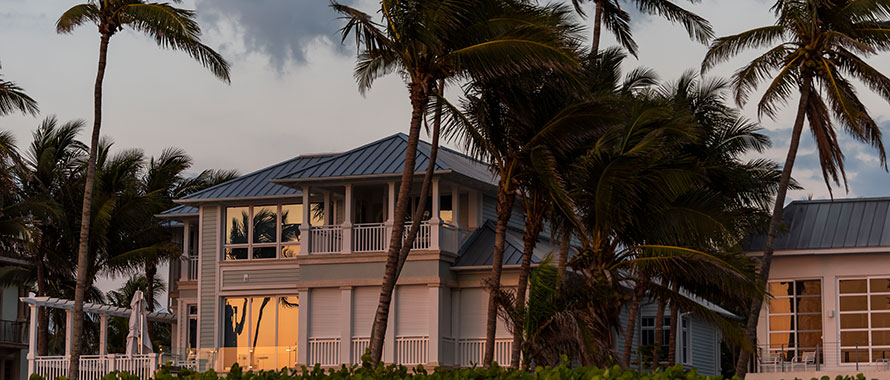Featured Solutions
Additional damage was reported in central Florida and in South Carolina after Ian was downgraded to a tropical storm and then made a second landfall as a Category 1 hurricane. The communities most severely affected face a long recovery ahead, with places like Fort Myers Beach being described as “like a war zone” due to the widespread damage.

Usually after a large catastrophic event, you can imagine the number of individuals making claims. The faster you put the claim in, the better off you are.
As evacuated residents and business owners return to their properties, safety is the top priority, said John Heaner, Associate Managing Director, Underwriter, Commercial Insurance, Burns & Wilcox, Tampa, Florida.
“The most important thing is to make sure they are taking care of themselves,” Heaner said. Then, it is a matter of mitigating any ongoing damage and contacting their insurance company. “Usually after a large catastrophic event, you can imagine the number of individuals making claims. The faster you put the claim in, the better off you are.”
Homeowners and commercial property owners making claims under their Homeowners Insurance, Commercial Property Insurance or Flood Insurance may face delays.
“What I would encourage is patience,” said Rick Sforzo, National Director, Claims Services, Burns & Wilcox, Atlanta, Georgia. “With the volume of claims that come in with these storms, it is impossible for carriers to get to everybody as quickly as they would like.”
Preparing for the worst-case scenario
In the wake of a disaster like Hurricane Ian, many affected property owners will find themselves learning for the first time what their insurance policies will and will not cover. This is an unfortunate reality, said Mike Spinazzola, Managing Director, Minuteman Adjusters, Detroit/Farmington Hills, Michigan.
“Everyone says to read your insurance policy. They are not always the easiest thing to read or the most exciting but reading them will give you insight into how the carrier will treat these situations,” Spinazzola said. “At the end of the day, knowing what you have on your policy is really important.”
This is particularly true now, as research shows the threat posed by hurricanes is on the rise as climate change contributes to more severe weather events, according to the New York Times. Warmer ocean temperatures mean stronger storms, and hurricanes may also last longer due to climate change, CBS News reported. Atlantic Canada recently suffered one of its most dangerous storms ever when Hurricane Fiona made landfall in Nova Scotia earlier in September, and that region is also expected to see an increase in severe storms due to climate change, according to The Conversation.
“The risk of hurricanes is significant,” Sforzo said. “If you are a resident in a coastal area, you can expect some type of significant storm to impact your life in some manner at some point.”

If you are in a danger zone or told to evacuate, then take your documents, protect what you need, and get out. … Property can be fixed, but lives certainly cannot be replaced.
Property owners can prepare for this risk by obtaining and regularly reviewing their Homeowners Insurance or Commercial Property Insurance, which can help pay for damage due to wind and other hurricane-related destruction. Flood Insurance is also critical, as most property policies exclude flood. Property owners can also educate themselves on the steps to take in advance of a hurricane, including boarding up windows, securing outdoor furniture and protecting valuables.
“Individuals in these areas usually have a pretty good idea of how to protect their property as much as possible,” Sforzo said. “If you are in a danger zone or told to evacuate, then take your documents, protect what you need, and get out. If there is damage, you can address that after the fact with the assistance of your insurance carrier and contractors. Property can be fixed but lives certainly cannot be replaced.”
Homeowners should keep an up-to-date inventory of their contents and take photos of the entirety of their homes before they evacuate, if possible, Spinazzola said. Also keep important documents on hand or stored digitally, from insurance policies to proof of home upgrades. “If you have higher-end cabinets versus builder’s grade, for example, it is best to keep that documentation in the event of a claim,” he said. “Individuals do not necessarily think about those things, but that can cause delays in the claims process.”
As claim progresses, use caution when hiring contractors
When returning to a property after a hurricane, FEMA recommends first checking for safety hazards such as downed power lines, foundation cracks, or sagging floors or ceilings. Homeowners should turn off their power and water systems until they are checked by a professional, according to FEMA.
Although homeowners should begin the insurance claims process before starting repairs, emergency mitigation measures to prevent further damage — like fixing an actively leaking pipe — can and should be taken, Spinazzola said. “Almost every insurance policy requires that you mitigate,” he said. “You want to make sure it is safe and then make any temporary repairs.”
Photos should be taken of property damage whenever possible, Sforzo advised. “Take pictures, immediately get it reported, and then be patient and allow the insurance company to get back to you with some instructions on what you need to do,” he said.
If you are unsure which insurance policy — Homeowners Insurance versus Flood Insurance, for example — would respond to your claim, “notify both and let the insurance companies work it out,” Sforzo suggested. “Insurance companies have tools to determine whether damage was caused by flood or wind.”
Homeowners in areas hit with widespread hurricane damage can be vulnerable to scams and contractors who may attempt to take advantage of the situation, Sforzo and Spinazzola agreed.
“You need to be wary of contractors or anyone knocking on doors trying to churn up a claim. They have a financial interest in the claim process,” Spinazzola said, pointing to the example of a roof contractor who may claim all slopes of a roof are damaged when they are not, leading to a prolonged claims process. “A lot of times individuals do not realize they control the repair process with the contractors they use.”
Homeowners and business owners should seek out references and reviews for potential repair contractors and avoid signing any agreements until they speak with their insurance company. “Unfortunately, individuals try to take advantage of others in these unfortunate circumstances,” Sforzo said. “Do not prematurely agree to have money going out because there are times where if you pay something, and there may be a coverage issue, you could end up being out of pocket for that.”
There should be “a lot of dialogue” between the field adjuster assigned to the claim and the policyholder during this process, Heaner added. “The best thing for the insured to do is be in constant contact with the adjuster,” and respond promptly to any requests for more information, he said. “The claims process can be straining because something bad just happened and you are waiting for an outcome, but the carrier has to do their due diligence as well.”
The field adjuster “is really their lifeline to the insurance carrier,” Spinazzola said. Homeowners should also be on the lookout for contractors who claim they will “pay” their deductible. “That is really insurance fraud,” he said. “That contractor is just going to inflate the cost of the repair, the loss might end up being more than it should have been, and their rates are just going to go up.”
Understanding loss of use, business income coverage
While the full extent of Hurricane Ian’s destruction remains to be seen, insurers could face up to $57 billion in losses from damage in Florida and South Carolina, Reuters reported on Oct. 3. It is estimated that insurance claims from Hurricane Fiona, which hit Canada in September, could reach $700 million, the Globe and Mail reported.
Beyond property damage, many hurricane victims will be displaced from their homes for an extended period of time and incur hotel, food and other expenses. These can be covered by Homeowners Insurance, with certain limits, Sforzo said. “If you are going to a hotel, be sure to look at your policy and see if there is a limitation on the cost,” he said. If you are unsure, “use your reasonable good judgment, and keep all of your receipts for meals.”
Business owners who have insurance coverage for loss of business income should be prepared with at least 12 months of profit-and-loss statements, which are generally required during the claims process, Spinazzola noted. They should know that a 72-hour waiting period may apply and that coverage for area power outages is not typically included. “That comes as a shock to some folks,” he said. “If you did not have actual damage to your business and the power was just out, that is not usually a covered loss on the policy.”
While FEMA funding may be available for hurricane-related damages in the U.S., property owners should know that they can still submit a claim to their insurance company. In fact, qualifying for assistance may require that the homeowner submitted an insurance claim and was denied, Spinazzola said. The same goes for funding that may be available through the Small Business Administration for commercial property owners who suffered hurricane damage.
“They may want to see that a claim was denied or below the deductible,” he said.
If a property owner is questioning whether their damage is enough to constitute an insurance claim, “What I would say is file the claim,” Sforzo said. “There are times where you may think that it is not as bad as it actually is.” What looks like just a few missing shingles, for example, could actually be more serious roof damage that is not discovered until the next major rainfall, he said.
After a property owner has completed necessary repairs and their insurance claim is closed, they should set aside time to review their insurance policies with their broker and ensure those policies will meet their needs moving forward. “If something was not covered, it is important to work with your broker to understand why that was and if that coverage is available,” Sforzo said. “Make sure you have all the protection you need going forward.”







